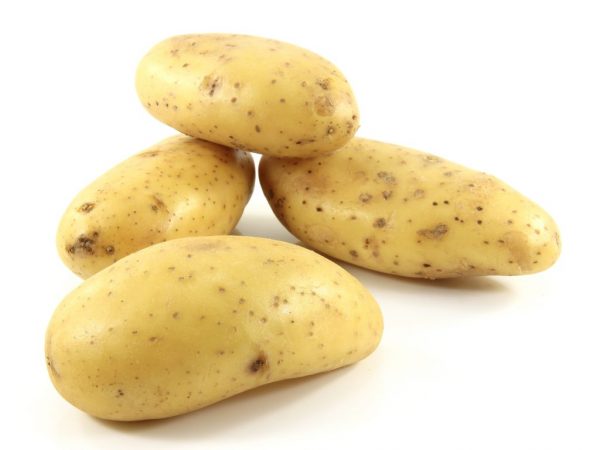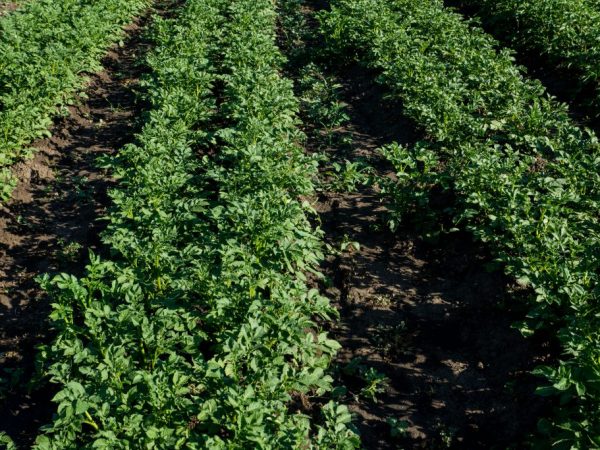Description of potato Empress
Potatoes are rightfully considered one of the most popular vegetable crops around the world. It is used boiled and fried, as an ingredient in first courses and as a side dish for meat and salads. This root crop grows in almost every garden. Among the many varieties, there is one called Empress potato. What are the features of its characteristics?

Description of potato Empress
Description of the variety
A variety of potatoes bred by Russian breeders. Its ripening period ranges from 70 to 90 days, which means that the variety belongs to the early ones and can be grown in any climatic zone of the country. It adapts very well to environmental conditions, bears fruit in any soil. Among the many advantages, one should also highlight resistance to diseases such as late blight and viral infections.
The yield is high - up to 10 tubers, weighing 65-150 g per bush (300-400 kg per hundred square meters). There is a possibility of increasing the yield when planting elite seeds. Fruit collection is carried out both in summer and autumn due to the good preservation of the tops. If the farmer wants to get the second portion of the crop, two months after germination, he must, having taken out ready-to-eat potatoes from the ground, cover the rest with soil and leave to ripen until the autumn frosts begin.
Description of the fetus
A rough idea of the variety can be made based on the description of the Empress potato variety:
- long oval tubers, yellow in color;
- small eyes;
- the flesh is creamy, of delicate consistency, of medium digestibility, has a pleasant taste.
Growing method
Biological seeds of the resistant potato Empress from air bulbs (green fruits) are grown for their own renewal. Super-elite, disease-free potatoes, in the first year of their life, are similar in size to peas.
By the age of three, they bring an excellent harvest. But in subsequent years, resistance to fungal diseases and attacks of parasites will decrease, as will the yield. Potato Empress will lose her "superpower" and will need seed renewal.
Seedling growing rules
Experts advise taking the seed in specialized stores, since new varieties will be bred from different species taken from their own gardens. The Empress has her own specifics in growing seedlings.
Since the seeds are quite small, they should not be covered with earth when sowing. Be prepared that sometimes almost half of the seeds don't germinate at all.
Growing from seed
Sow the seeds clearly in a row. Pour the earth into the container with the expectation that you will have to fill up as the shoots germinate. The roots should be on the surface. Some farmers prefer to add sand to the soil for more looseness. However, this is not the best option as it is too heavy. Better use peat or moss. Instead of planting in pots, use the picking method.Flexible plants can be deepened into the ground, twisted, etc.
Every 2 weeks, feed for 2 months with a special solution. When spring weeds appear, mix them up. If May is warm, start hardening the plant. Take it outside in a dark place for a couple of hours. Gradually increase the time to 10 hours, and then to a day. Just don't let the plant freeze.
The best temperature for growing a potato crop is 18 ° C. When the thermometer falls below zero, the potatoes begin to rot.
Growing in open soil

The plant needs sunlight
The first shoots are small tubers. Add to this feature the compactness of the Empress's bushes - it follows that the plants should be planted at a distance of 10-15 cm from each other and half a meter between the rows. But these parameters depend on the number of roots in one hole and other details.
Choose a well-lit hill for planting that is not under the threat of waterlogging.
Harvesting and storage
As the tubers mature and have a firm skin, begin harvesting. Only mature, mature potatoes are ready for wintering. If you are going to store the fruits in the cellar, pre-plant them with greenery and rinse with a solution of potassium permanganate.
The room temperature should be 2-5 degrees, and the humidity should be as high as possible (95%).
Potato care
As soon as the soil starts to dry out, feed the plant with water. This is especially important during the flowering period. Feed with manure, bird droppings, weeds. Spud. The variety, being quite unpretentious, does not require any special efforts on itself and grows well on its own. But, if the fruits are grown for sale, you need to apply techniques using agricultural technology. Then you are guaranteed to get a high yield of marketable potatoes.
After the hilling procedure, weed control can be started using chemicals - but strictly two days before the first shoots. Use a proven product that kills annual, perennial, dicotyledonous weeds. Best suited "Neon-99", "Remus" - 250 liters per hectare.
During the budding period, the plant needs special watering, with the addition of fertilizers. Hilling and loosening of the soil is carried out three times per season. Such processes ensure the flow of air into the rhizome and increase the intensity of club formation.
Mow the tops before digging the potatoes. After digging up the tubers, dry them in a well-ventilated area, but avoid direct sunlight. Before being sent for storage, the crop is subjected to chemical treatment.
Prophylaxis
The main rules are soil moistening and the use of phytolamps. The first shoots appear in cold March and immediately begin to stretch out. Your task is to provide them with maximum coverage. Place the seedlings on the south side and additionally connect artificial lighting.
One of the most important stages is the process of soil moistening. With improper care, those seeds that have been grown can dry out in the first week. The roots located on the surface are easy to ruin: they dry out quickly, and if excessively moistened, they can become infected with a black leg. Phytolamps are required - seedlings can wilt even in the presence of good natural lighting.
If preventive measures did not help, and the seedlings were struck by a black leg, and the tubers wither one by one, do not rush to despair. Use the so-called mulching or hilling. After watering the seeds, add a thin layer of dry earth to them. Always warm and dry soil will provide immunity to diseases. Water and renew the layers as they dry.


